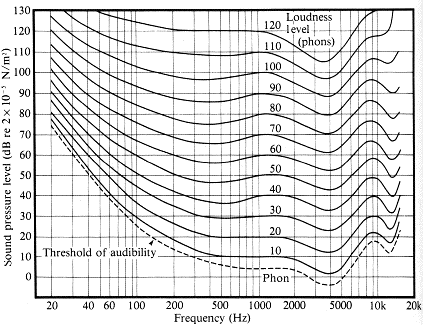[english ][all ] (請注意:中文版本並未隨英文版本同步更新! )
「音量」代表聲音的強度,又稱為「力度」、「強度」(Intensity)或「能量」(Energy),可由一個音框內的訊號震幅大小來類比,基本上兩種方式來計算:
每個音框的絕對值的總和:
volume = S i=1 n |si |
其中 si 是一個音框中的第 i 個取樣點,而 n 則是每個音框的點數。這種方法的計算較簡單,只需要整數運算,適合用於低階平台(如微電腦等)。
每個音框的平方值的總和,再取以 10 為底對數值,再乘以10:
volume = 10*log10 (S i=1 n si 2 )
這種方法得到的值是以分貝(Decibels)為單位,是一個相對強度的值,比較符合人耳對於大小聲音的感覺。以下網頁有對分貝的詳細說明:
http://www.phys.unsw.edu.au/~jw/dB.html (local copy )
音量具有下列特性:
一般而言,有聲音的音量大於氣音的音量,而氣音的音量又大於雜訊的音量。
是一個相對性的指標,受到麥克風設定的影響很大。
通常用在端點偵測,估測有聲之音母或韻母的開始位置及結束位置。
在計算前最好先減去音訊訊號的平均值,以避免訊號的直流偏移(DC Bias)所導致的誤差。
以下顯示如何以兩種方法來計算音量:
Example 1: volume01.m waveFile='sunday.wav';
frameSize=256;
overlap=128;
au=myAudioRead(waveFile); y=au.signal; fs=au.fs;
fprintf('Length of %s is %g sec.\n', waveFile, length(y)/fs);
frameMat=enframe(y, frameSize, overlap);
frameNum=size(frameMat, 2);
% Compute volume using method 1
volume1=zeros(frameNum, 1);
for i=1:frameNum
frame=frameMat(:,i);
frame=frame-median(frame); % zero-justified
volume1(i)=sum(abs(frame)); % method 1
end
% Compute volume using method 2
volume2=zeros(frameNum, 1);
for i=1:frameNum
frame=frameMat(:,i);
frame=frame-mean(frame); % zero-justified
volume2(i)=10*log10(sum(frame.^2)+realmin); % method 2
end
sampleTime=(1:length(y))/fs;
frameTime=((0:frameNum-1)*(frameSize-overlap)+0.5*frameSize)/fs;
subplot(3,1,1); plot(sampleTime, y); ylabel(waveFile);
subplot(3,1,2); plot(frameTime, volume1, '.-'); ylabel('Volume (Abs. sum)');
subplot(3,1,3); plot(frameTime, volume2, '.-'); ylabel('Volume (Decibels)'); xlabel('Time (sec)'); Length of sunday.wav is 0.98225 sec.
Example 2: volume02.m waveFile='sunday.wav';
frameSize=256;
overlap=128;
au=myAudioRead(waveFile); y=au.signal; fs=au.fs;
fprintf('Length of %s is %g sec.\n', waveFile, length(y)/fs);
frameMat=enframe(y, frameSize, overlap);
frameNum=size(frameMat, 2);
opt=frame2volume('defaultOpt');
opt.method='absSum';
volume1=frame2volume(frameMat, opt);
opt.method='decibel';
volume2=frame2volume(frameMat, opt);
sampleTime=(1:length(y))/fs;
frameTime=frame2sampleIndex(1:frameNum, frameSize, overlap)/fs;
subplot(3,1,1); plot(sampleTime, y); ylabel(waveFile);
subplot(3,1,2); plot(frameTime, volume1, '.-'); ylabel('Volume (Abs. sum)');
subplot(3,1,3); plot(frameTime, volume2, '.-'); ylabel('Volume (Decibels)'); xlabel('Time (sec)'); Length of sunday.wav is 0.98225 sec.
Example 3: volume03.m waveFile='sunday.wav';
au=myAudioRead(waveFile);
opt=wave2volume('defaultOpt');
opt.frameSize=256; opt.overlap=128;
time=(1:length(au.signal))/au.fs;
subplot(3,1,1);
plot(time, au.signal);
xlabel('Time (sec)'); ylabel('Amplitude'); title(waveFile);
subplot(3,1,2);
opt1=opt; opt1.frame2volumeOpt.method='absSum';
vollume1=wave2volume(au, opt1, 1);
ylabel(opt1.frame2volumeOpt.method);
subplot(3,1,3);
opt2=opt; opt2.frame2volumeOpt.method='decibel';
volume2=wave2volume(au, opt2, 1);
ylabel(opt2.frame2volumeOpt.method); 基本上我們使用音量來表示聲音的強弱,但是前述兩種計算音量的方法,只是用數學的公式來逼近人耳的感覺,和人耳的感覺有時候會有相當大的落差,為了區分,我們使用「主觀音量」來表示人耳所聽到的音量大小。例如,人耳對於同樣振福但不同頻率的聲音,所產生的主觀音量就會非常不一樣。若把以人耳為測試主體的「等主觀音量曲線」(Curves of Equal Loudness)畫出來,就可以得到下面這一張圖:
Curves of equal loudness determined experimentally by Fletcher, H. and Munson, W.A. (1933) J.Acoust.Soc.Am. 6:59.
上面這一張圖,也代表人耳對於不同頻率的聲音的靈敏程度,這也就是人耳的頻率響應(Frequency Response)。如果你要測試你自己的耳朵的頻率響應,可以到這個網頁「Equal Loudness Tester」試試看:
http://www.phys.unsw.edu.au/~jw/hearing.html (local copy )
主觀音量除了和頻率有關外,也和音訊的內容(音色或是基本週期的波形)有關,例如,我們可以盡量使用相同的主觀音量來錄下幾個發音比較單純的母音(ㄚ、ㄧ、ㄨ、ㄝ、ㄛ、ㄜ、ㄩ),然後再用音量公式來算它們的音量,就應該可以看出來音量公式和發音嘴型的關係。
Example 4: volume04.m waveFile='aeiou.wav';
au=myAudioRead(waveFile);
opt=wave2volume('defaultOpt');
opt.frameSize=512; opt.overlap=0;
time=(1:length(au.signal))/au.fs;
subplot(3,1,1);
plot(time, au.signal);
xlabel('Time (sec)'); ylabel('Amplitude'); title(waveFile);
subplot(3,1,2);
opt1=opt; opt1.frame2volumeOpt.method='absSum';
vollume1=wave2volume(au, opt1, 1);
ylabel(opt1.frame2volumeOpt.method);
subplot(3,1,3);
opt2=opt; opt2.frame2volumeOpt.method='decibel';
volume2=wave2volume(au, opt2, 1);
ylabel(opt2.frame2volumeOpt.method); 主觀音量容易受到頻率和音色的影響,因此我們在進行語音或歌聲合成時,常常根據聲音的頻率和內容來對音訊的振福進行校正,以免造成主觀音量忽大忽小的情況。
Audio Signal Processing and Recognition (音訊處理與辨識)

